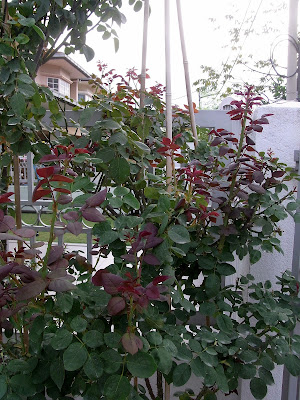Learn what basal breaks and new shoots are and how to take care of them.
What is a basal break?
A basal break is the emerging of new cane from the base of the plant or from the ground. It is very desirable and much awaited by rose growers as it yields the biggest flowers, presents lots of new bud eyes for later growth, and will replace older, worn out canes. For this reason, some rose growers provide their roses with the best nutrients to force them into basal breaking.
 |
| Basal break - the ticket for more blooms! |
Basal breaks may also arise within five inches or so of the bud union / grafted union.
Some basal breaks do sprout from the ground. For own root roses, these basal breaks are the most desirable as they produce much stronger and bigger canes.
Some rose hobbyists follow what a commercial rose grower, Rayford Reddell (Source: his book title Growing Good Roses), recommends in his book, that is pruning basal breaks at a bud eye when the cane is twelve to fifteen inches tall to encourage a sturdy branched cane that will produce more and better blooms (why? more energy is focused on much shorter cane!).
For grafted roses, any basal breaks that sprout from the ground are called suckers and should be removed. Suckers are not the original roses as they come from the understocks / rootstocks.
What is a new shoot?
New shoots are simply new stems sprouting along the existing canes or branches. Roses grow by producing many new shoots, it is the quickest way of producing volume; that is leaves and flowers.
They also act as replacements when old canes or some part of the plants die off or turn woody. When the upper part of a stem dies or being cut away, the lower part produces new shoots immediately.
Do you know that 90% of basal breaks or new shoots are made from water? Lots of rain interspersed with nice sunny days during this monsoon season has given my roses lots of happy new shoots.
 |
| Two equally strong new shoots emerge from the same cane. |
 |
| They seem to grow the same cane diameter as the old cane where they emerge from. I called these shoots as 'extensions' as they will produce equally large quality flowers and not reduced ones. |
How to care?
Care should always be taken not to disturb new growths. These shoots will grow very rapidly and are easily broken off by the wind. Protect them with a small stake if necessary and avoid touching them. Also, cut away any branches or canes that are in their way as the thorns could hurt the fragile growth.
The loss of a basal break is an unhappy event for any rosarian.
And as usual, provide the plants with sufficient nutrients and water at this time of rapid growth.
Happy rose growing!
Copyright of Rough Rosa






6 comments:
Very informative and helpful article. Since reading your blog I have learned so much. Thank you.
I noticed my rose plants are also doing much better these couple of months with the rain and all. And as you mentioned, lots of new growth.
You have huge rose plants! 90% of new shoots are made from water? i should water my roses more now!
You have great green thumbs for roses! All your roses look so great. Thanks for listing down these info. It's really good to know.
Sun Ni@ u'r welcome. Glad I am of a help :)
Malar@Yup..water plays a major role. Timing has to be right.
Step@ I wish I hv more time to write things that I know... I found many are very interested in planting roses but few know the hows. If only, then all of us could enjoy roses!
Hi,
Thanks for visiting my blog. This basal cane post has been very useful. I was in Malaysia recently and in saw very nice gardens in some homes. I saw these mostly around the Brickfields area as I visited there quite often for meals.
Hi Natti - Hope u had a great time in Malaysia. Indeed, some houses here do have nice gardens. The Brickfields is one of the rich neighborhoods. Gardening/landscaping culturally is not Malaysian thingy but probably only since late 20 years or so. Before, gardening to Malaysian has been somewhat growing tropical fruit trees in the backyards and very few local ornamental plants alongside. The culture changed when more ornamental plants suit tropical climate are brought in from temperate climate and made available.
Post a Comment